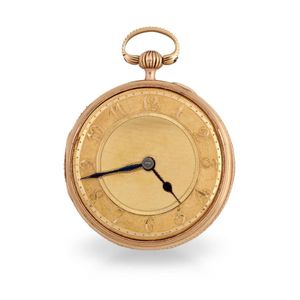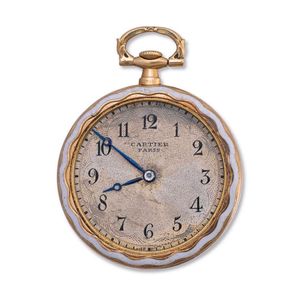Enamel and Diamond Cartier Watch from Melba Collection
You must be a subscriber, and be logged in to view price and dealer details.
Subscribe Now to view actual auction price for this item
When you subscribe, you have the option of setting the currency in which to display prices to $Au, $US, $NZ or Stg.
- Movement - The technical name for the workings of a clock or watch, and does not include the dial or case.
- Guilloche - A form of classical decoration consisting of a repeating ornament of interlacing curved bands, sometimes forming circles, and further decorated with rosettes or other flower forms.
The name is derived from the inventor, French engineer Guillot, who invented a mechanical method of inscribing fine repeating patterns on to metallic surfaces.
On enamelled items with guilloche decoration, the surface is firstly engraved with the repeating pattern, and then covered with several layers of enamel, each of which is fired.
Where the item has not been enamelled the form of decoration is usually called "engine turned". - Circa - A Latin term meaning 'about', often used in the antique trade to give an approximate date for the piece, usually considered to be five years on either side of the circa year. Thus, circa 1900 means the piece was made about 1900, probably between 1895 and 1905. The expression is sometimes abbreviated to c.1900.
- Bezel - On a clock or watch, the bezel is the metal frame into which the watch or clock glass is fitted. In clocks, the bezel may include a hinge and a flange, in effect a door to the face of the clock. In jewellery the bezel is a band of metal with a projecting lip that holds the gemstone in its setting.
- Keyless Watch - A keyless watch is a type of pocket watch or wristwatch that does not require a separate winding key to wind or set the time. Instead, a keyless watch is wound and set by a small knob or button located on the side of the watch, called a crown.
Keyless watches were first introduced in the late 19th century and quickly became popular due to their convenience and ease of use. Prior to the development of keyless watches, pocket watches were typically wound and set using a small key that was inserted into a hole in the watch case. The key would be turned to wind the watch's mainspring, and then turned again to set the time.
With the introduction of the keyless watch, watchmakers were able to simplify the winding and setting process by eliminating the need for a separate key. Instead, the crown on the side of the watch could be pulled out to set the time, and then pushed back in to wind the watch's mainspring.
The keyless watch design has since become the standard for most modern watches, both pocket and wristwatches. In addition to being more convenient to use, keyless watches are also typically more reliable and accurate than earlier models that used winding keys.
This item has been included into following indexes:
Visually similar items

A very fine George III gold open face pocket watch, 1807, hallmarked 18ct gold case London with engine turned decoration to back cover and dial. Low relief Arabic numerals. Verge movement by 'Tho Mots' Ludgate Street N.4917. Engraved cockplate with diamond

Patek Philippe An 18ct gold openfaced keyless lever watch mvt 803922 circa 1925, nickel lever movement, 18 jewels, gold cuvette, gilt dial, Breguet numerals, subsidiary seconds, polished case engraved with initials WTM, case, dial and movement signed, diam

David Morice An 18ct gold open-faced pocketwatch mvt 4429 English circa 1840, english fusee cylinder movement signed and numbered David Morice, Fenchurch Street no. 4429, cylindrical pillars, diamond endstone, gold engine-turned dial, Arabic numerals, blue

A Waltham 14ct gold open face pocket watch; golden coloured dial, Arabic numrals, subsidiaary seconds dial (cracked glass) on a 17 jewel stem wind movement signed A.W. W. Co. S/N 24142701. C 1922. Back cover with monogram. Width 44 mm. Wt. 70.3g.
